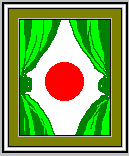| Institutionalization of the Sakura Flower |
 A Window on Japan
A Window on JapanEpisode 6
The Japanese have a propensity to make a ceremony out of everything. How many times have you zipped down to the campus entrance back home, stood in front of the mobile stall and drank scalding cha from a glass tumbler? Countless, I'm sure. Never having giving it a second thought. Well, trust the Japanese to institutionalize that simple event into the very elaborate Tea Ceremony.
Few things however, stir them up as, come spring, the sakura flower blooms ("Sakura" is the Japanese name for Cherry Blossom flowers). The whole country seems to go into a trance as thousands upon thousands of trees in gardens and avenues and backyards all over the country begin to bloom at the beginning of the spring season, all at the same time they say.
The long bitter winter (particularly for the northern regions) winds up its act and it is the turn of Spring to carry on the show. And what better way to announce it than the Sakura blooming. All winter, the trees waited, like coatless sentries, their leaves having been shed. From a distance it did look a bit sad, all those stripped trees. But a close look at them revealed the tiny buds just waiting for the winter to end so that they could burst forth in colour and scent (and had they the ability to speak, in song too, I'm sure!), taking the whole country into a sort of druggy high.
And the Japanese people wait by the side to applaud and cheer it on. The role of the Weather Bureau is to make weather forecasts, right? In Japan, they have an additional role to play - that of making Sakura Blooming forecasts!! Newspapers are now publishing "Sakura Forecasts" and contour lines are drawn across the country, indicating where and when the bloom will take place. Dates, data and drawings are included. This time, the blooming is forecasted to begin ranging from 25 March in the southern islands to 25 April in the north (Tokyo around the 3rd of April).
The blossoms last for about two weeks, and what do the Japanese do in the meantime? View them, of course. Being what they are, such viewings are called "hanami" ("hana" is flower and "mi" is to look - in other words "Viewing of the Flower") creating an entire ceremony out of it! Major Gardens in the Tokyo area, for example, send out newspaper announcements for the public to "attend" the "viewing ceremonies" in the Garden. Concerts of traditional music are sung, and special chairs and platforms are erected in many places from where panoramic views can be obtained. Hours together are spent on TV debating the onset, quality, quantity and a hundred different things about the flower. Artists bring out their easels and cameras click away to glory, as miles upon miles of videotape is shot. For the family outing, for example, the traditional/standard thing to do (and still being done) is to go to a park where the flower is in bloom, spread a mat under it, sit down and drink sake (rice wine, the national drink of Japan - and pronounced sa-ke), and sing songs. Or just your small backyard sakura tree is also quite alright for this.
As the cycle of seasons move on, I am waiting for this season's sakura blossoms, caught up in the all-pervading sense of a whole nation's expectation. Teetotaller that I am, for once it is tempting to drop my defenses and join the Japanese in their hanami and drink sake under the sakura blossoms and revel in its beauty.
In this land of Tofu, Toshiba and Tsunamies, there will always be a corner of the Japanese heart (and mine) reserved for the romancing of the "Sakura" Institution.
PS: Precursor to the Sakura blossom, the "Ume" or Plum flowers bloom in the first two weeks of March, and is in fact now in progress. Though not as all-prevailing as Sakura, they are equally pretty, harking the still greater beauty that is to visit the land.



Go back to Episode 5
 Go on to Episode 7
Go on to Episode 7